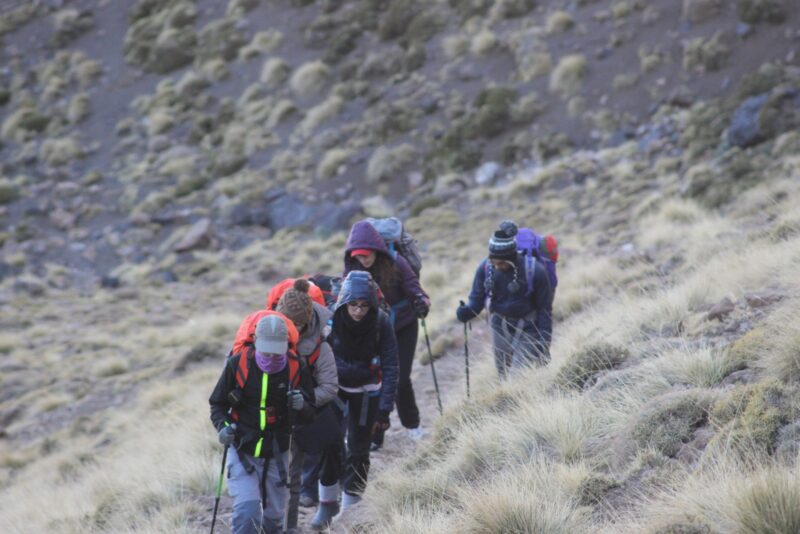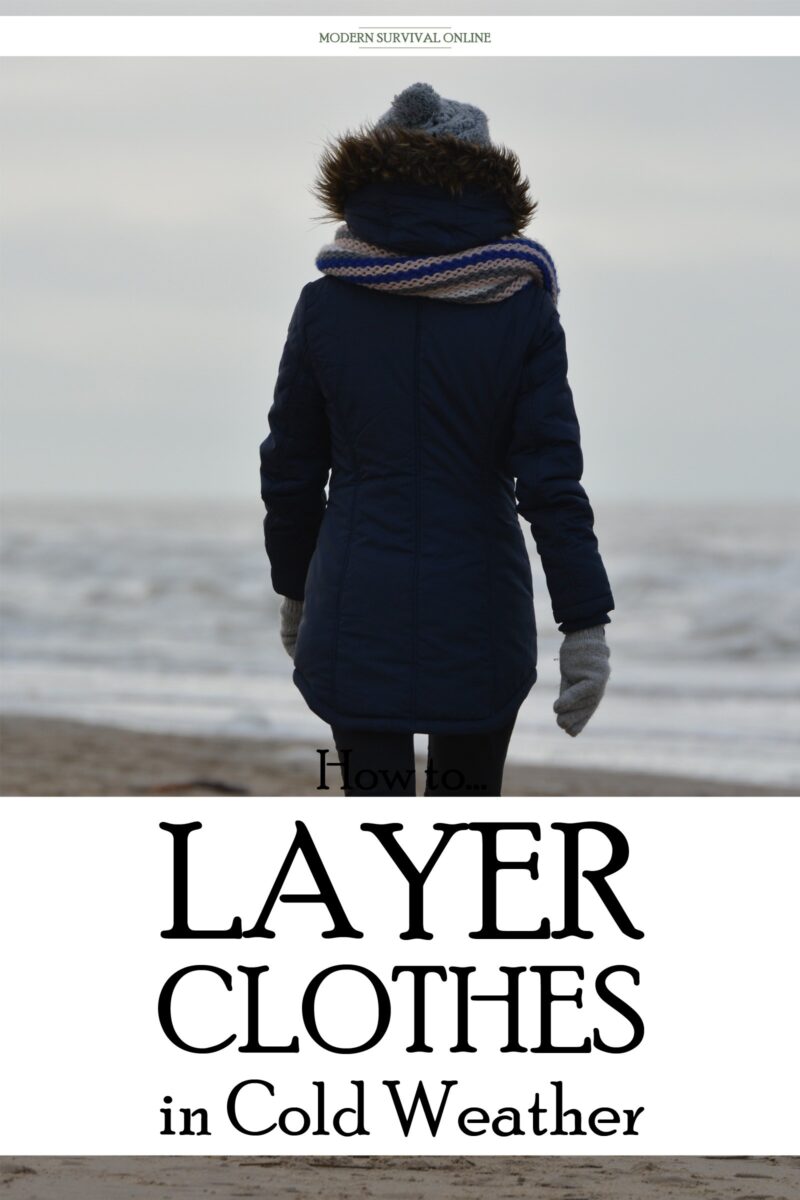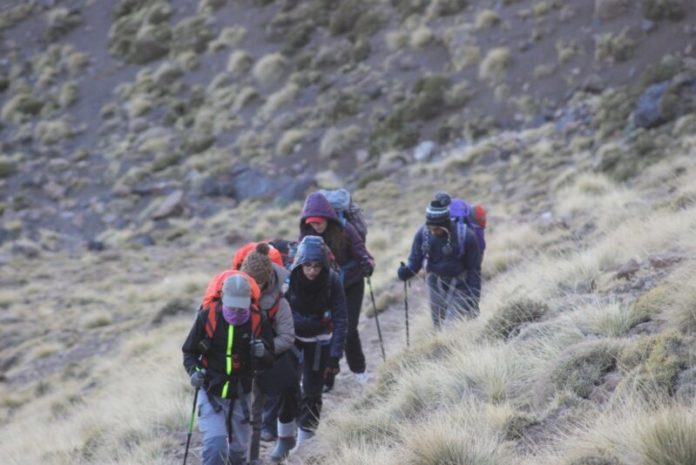One of the most significant environmental threats that any of us will face when it comes to exposure is that posed by deep cold. Temperatures that are near or even below zero combined with brisk winds can quite literally freeze you solid in a terrifyingly short period of time.
Staying warm is vital, but even in the middle of a survival situation other tasks will not wait and you must be able to regulate your body temperature effectively for the task at hand. That means you’ll need to use layering.

So how do you layer your clothing to stay effective in cold weather?
Layering is a relatively simple process where you will keep a fast drying, moisture-wicking layer against your body, and a light, fluffy layer on top of that in order to trap warm air. Lastly you will surround the whole thing with a weatherproof outer layer that will help you beat the wind and precipitation.
Proper layering is very effective because it will keep you warm and also let you cool down before you get too hot and start sweating.
If you think all you need to do to beat cold weather is pile on ever more clothes or invest in a single super garment then you should think again.
Choosing the wrong clothing or even choosing the right clothing and wearing it in the wrong order could potentially be a death sentence in the coldest environments. Read on to learn everything you need to know in order to beat the deep freeze.
Cold Weather Can Kill Quickly
You might not ever be truly comfortable when you are out and about in the coldest environments or weather, but it is possible to dress in such a way that the cold will not gnaw your bones.
This is of course a much simpler task when you’re out on a pleasure hike, ski trip or mountainside adventure. What do the rules still apply when you’re in the middle of a survival situation?
Things are going to be even harder. Getting cold will not be elective because you are definitely going to get cold and you won’t be able to retreat inside a toasty lodge, properly heated house or vehicle or any place else that can afford you legitimate shelter.
The cold will be gnawing at you, all around you like a malevolent force, constantly looking for a way in. When conditions are perfectly bad cold weather can kill you, dead, in as little as a couple of hours and frostbite can set in on your extremities even faster.
The stakes will certainly be high.
Avoid Sweating
Avoid sweating? How in the heck are you supposed to do that? Whatever, you had better think of a way because working up a good lather in a cold environment might mean certain disaster.
You’ll need to worry about getting too warm. If you get too hot for any reason be it through exertion or just hanging out too close to the fire or in a warm and toasty vehicle you will start to sweat and that means your skin will be wet.
Wet clothing or skin that is exposed to cold temperatures to say nothing of a cold blast of frigid wind will be chilled precipitously.
If this so happens to be your hands, feet or face you can expect frostbite to set in much faster than usual and you’ll be able to do precious little about it under the circumstances. No matter what you were doing or where you are that is trouble you can scarcely afford.
It might sound like an odd sort of conundrum but as it turns out getting too warm will not be an issue so long as you dress appropriately because the right outfit will allow you to regulate your temperature, venting heat when you start to get too hot and trapping the heat when you need to warm up. I will tell you all about it in the next section.
Layering for Cold Weather Success
Even if you are a total newbie to layering you will find that it is pretty easy to do it correctly so long as you have decent clothing to work with.
The purpose of layering as alluded to above is to allow you to move moisture away from your skin while trapping a layer of warm air next to you and keeping cold air off of you.
It sounds like you need a miracle to do that but you don’t; you just need the right clothing put on in the right order. A description of the layers you should utilize, in order from inner to outer is below:
Base Layer
Your base layer is the first layer you put on over your underwear. It rests directly against your body and has an important job, namely wicking away sweat so you won’t get flash chilled as mentioned above.
The best tool for the job is either a modern synthetic fabric blend that is quick drying or a trusty standby, Merino wool.
This garment layer should be lightweight, thin and form fitting. Also, make sure you avoid cotton like your life depends on it because it does: Cotton soaks easily and takes ages to dry meaning it is a total liability in cold weather.
Mid Layer(s)
After your base layer comes the mid layer or mid layers. You will employ one or two depending on what garments you are working with and overall conditions, with the most hostile conditions mandating an additional mid layer.
Again, depending on circumstances, your mid layer will typically be a lightweight, fluffy garment that is primarily responsible for trapping a large volume of air that is warmed by your body heat, keeping you warm.
If you are using more than one mid layer the first mid layer after your base layer should be a slightly heavier garment that is also warm with the large, puffy layer put on after that. Good choices are synthetic blends and wool again. Once more you should avoid cotton.
Outer Layer
You can think of your outermost layer as a shell against the outside atmosphere and elements. This layer is responsible for blocking wind which will strip all of your heat away with frightening speed and blocking precipitation in the form of snow or rain.
You must choose your outer layer garment carefully because it need not be completely impervious to moisture or at least moisture coming from the inside. If this garment is not breathable you will start getting soaked with sweat and that means the cold will soon have you.
Hats, Gloves, Boots, etc.
It stands to reason that you will need additional cold weather gear that does not fit precisely into one of these categories but should nonetheless be chosen depending on your activity and other requirements. Headgear is a must as the extremities of the head and face are particularly vulnerable to frostbite.
Foldable flaps might be a good option for a hat. Winter boots should be waterproof but also breathable as with your outer layer and be roomy enough to accommodate a second pair of socks.
Gloves or mittens can be chosen at your leisure with the understanding that gloves will provide you with better dexterity but mittens will keep your hands warmer because they allow each finger to share warmth with its neighbor. Also don’t forget to include face masks or scarves and goggles as appropriate.
Color Selection Matters
Unless you are dressing for concealment, make sure all of your clothing including your innermost layers are anything but white.
You won’t necessarily be in a place that is covered in snow but white is, generally, a very poor choice of color if you want to be seen from any distance away. It is definitely the worst choice for snowy environments because it is effectively invisible.
There is a reason skiers, hikers and other cold weather personalities always choose loud, clashing neon colors and it isn’t because they were born without a sense of fashion.
This is it because it makes them easy to see, especially from the air. Keep this in mind when you are choosing cold weather clothing unless discretion is high up on your list of priorities.
Conclusion
Proper layering of clothing in cold weather can often make the difference between a successful outing or even outright survival and disaster or death.
Only by correctly choosing and layering your garments will you be afforded the capability to regulate your temperature, preventing sweating that can result in a drastic lowering of your body temperature.
This system will also afford you the flexibility to deal with changing temperatures, changing conditions and new circumstances.



